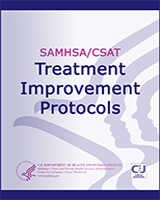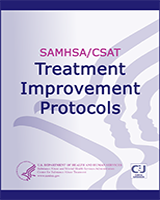NCBI Bookshelf. A service of the National Library of Medicine, National Institutes of Health.
Center for Substance Abuse Treatment. Assessment and Treatment Planning for Cocaine-Abusing Methadone-Maintained Patients. Rockville (MD): Substance Abuse and Mental Health Services Administration (US); 1994. (Treatment Improvement Protocol (TIP) Series, No. 10.)
This publication is provided for historical reference only and the information may be out of date.

Assessment and Treatment Planning for Cocaine-Abusing Methadone-Maintained Patients.
Show detailsMuch of the research on treating patients for opioid and cocaine abuse has focused on treatment for either opioid or cocaine dependency. Recent research has concentrated on cocaine use by concurrently dependent methadone treatment patients. A variety of studies have been conducted with these patients to address the use of pharmacotherapies and psychosocial interventions. As noted previously in this TIP, methadone used for treating opioid addiction has a limited impact on cocaine abuse, and the details of how cocaine and methadone or other opioid maintenance treatment drugs interact remain a question.
Progress has been made, however, in identifying possible approaches appropriate for treating both problems. Several studies of the use of contingency management, antidepressants, and opioid maintenance agents in treating concurrently dependent patients show promising but not definitive results. In addition, a variety of other approaches to treating concurrent dependence have been tried, including acupuncture, amino acid therapy, hypnosis, and meditation. Data showing the efficacy of these approaches are lacking.
This chapter reviews current knowledge about treatment approaches being researched and suggests areas for further research.
Pharmacotherapies
Several medications are being researched to evaluate their effectiveness for treating patients concurrently dependent on opioids and cocaine. Most of the studies, however, have been hampered by methodological problems including lack of adequate controls, lack of consistent outcome measures, and lack of standardized types and intensity of accompanying psychosocial interventions (American Psychiatric Association 1994). Over 30 medications have been studied, including a variety of antidepressants, dopamine agonists, alternative agents to methadone, and other pharmacologic agents purported to either block the acute effects of the stimulant or reduce drug craving.
It must be noted that these medications should be used only in controlled research settings. Many of the medications are potentially toxic and should not yet be used as part of a larger methadone treatment protocol until further evaluation has proven their efficacy. In particular, naltrexone would precipitate methadone withdrawal in such patients, and the use of buprenorphine is also contraindicated for them.
Medications Under Evaluation for Use With Patients Concurrently Dependent on Opioids and Stimulants
Bupropion
Contingency Management
As discussed in chapter 4, some MTPs implement contingency contracts with their patients. These techniques have received extensive systematic evaluation. However, more information would be useful to assess the effectiveness of specific contingency contract procedures, to work out optimal parameters and conditions for implementation, to develop more effective interventions, and to determine the characteristics of multidrug-abusing patients who respond to different types of interventions.
Acupuncture, Electroacupuncture, and Cranial Electrostimulation
Acupuncture, electroacupuncture, and cranial electrostimulation are techniques that have recently been used in treating opioid addiction. Acupuncture is the insertion of thin needles subcutaneously into the body at specific points that represent centers of energy. Electroacupuncture refers to the procedure of applying small amounts of electricity to needles or staples applied to the skin at acupuncture points. Cranial electrostimulation is the application of small amounts of electricity to the central nervous system through electrodes applied to the skin over the cranium.
In China, acupuncture is widely used as a therapy for a variety of ailments. It is believed that the normal functioning of the body depends on a balance of two opposite polar energies, yin and yang. These energies flow along lines of the body called meridians. There are approximately 1,000 acupuncture points along each meridian. Stimulation of the points by needles is believed to correct the imbalance of energy flow, release blockages of energy, and enhance the body's natural capacity to heal itself (Nebelkopf 1981). Effective relief of narcotic withdrawal symptoms with acupuncture was first recorded in Hong Kong in the early 1970s (Wen and Cheung 1973).
Acceptance of such techniques in the United States has been slow because of the scarcity of controlled clinical studies of efficacy, although Bullock and coworkers (1989) report on studies conducted for severe recidivist alcoholism. Research in laboratory models has provided some evidence that acupuncture's effects are due to stimulation of the body's endogenous opioids. These endogenous opioids are naturally occurring neurotransmitters in the body with analgesic properties and thus may work to reduce the painful symptoms associated with drug withdrawal.
Although acupuncture is not viewed as a cure for addiction, it has been used to ameliorate withdrawal symptoms and drug craving in some patients, and positive effects have been claimed in the following areas:
- Retention in treatment and corresponding decrease in relapse
- Enhancement of other treatment processes due to reduction in anxiety
- Reduction in sleep problems and nightmares that patients in detoxification treatment frequently experience (Bullock et al. 1989; Smith 1986)
Acupuncture is also frequently used for symptomatic treatment of early abstinence as well as part of a comprehensive treatment plan including psychosocial services, drug testing, and social reintegration. It can be cost effective in an outpatient setting because equipment needs are minimal and overhead is low; in addition, advances in treatment technology have made disposable acupuncture needles available.
No known existing outcome studies adequately test the efficacy of acupuncture, electroacupuncture, and cranial electrostimulation for treatment of concurrent dependencies or for cocaine alone. Acupuncture may be most helpful as an adjunct to other therapies rather than as a stand-alone treatment. It is believed that the best results occur when acupuncture is combined with psychosocial and biomedical treatment strategies. Further research is required to verify use of these treatment modalities and to develop standards for their use.
Amino Acid Therapy
Reports that amino acid therapy has been useful in treating cocaine dependency have been published. These reports claim that administration of amino acids that are precursors for neurotransmitters involved in cocaine use will replenish the supply of neurotransmitters depleted by such abuse (Trachtenberg and Blum 1988). Further research is needed to test this theory.
Hypnosis
Hypnosis has been used in treating phobias and nicotine dependence, and clinicians have reported its use to treat a variety of other addictions. Minimal documentation exists on using hypnosis to treat heroin and cocaine addictions.
Meditation
Transcendental meditation (TM) is one of several approaches to meditation. TM uses a focused mental relaxation technique practiced twice a day for 20 minutes. It has been reported to be effective in diminishing stress and results in a broad range of physiological, psychological, social, and intellectual benefits (O'Connell 1991). As an adjunct to substance abuse treatment, TM theoretically could reduce the frequency and intensity of drug cravings, as well as improve psychological and emotional functioning. In describing TM's appropriateness, Bloomfeld (1975) points out that it is compatible with AA and NA program philosophy and can potentiate the effects of counseling, psychotherapy, and other ongoing treatment components.
While research is not currently available on other types of meditation for substance abusers, given similar principles and benefits, meditation in general may prove to be an effective adjunct to more traditional treatment approaches.
Areas for Further Research
The current studies of treatment approaches indicate the need for further research. Lack of data replication poses questions about the implications of study results. Large-scale clinical trials to assess the efficacy of various medications have not been conducted. Confusion over the distinction between use, abuse, and dependence on concurrently used substances causes difficulty in defining appropriate treatment services for individual patients. Standardization and refining of instruments to detail drug patterns, routes of administration, and duration of use is important for the field to advance.
A variety of research topics have been suggested by Consensus Panel members and consultants:
- Analyses of the pharmacological interactions between cocaine and methadone, LAAM, buprenorphine, and naltrexone
- Analyses of the interactions between methadone and other opioid maintenance medications (including LAAM, buprenorphine, and naltrexone) and antidepressants used to treat cocaine craving
- Assessment of the consequences of various clinic policies regarding patient length of stay and retention issues
- Analysis of the determinants of successful patient-treatment matching
- Assessment of the efficacy of various medications
- Analysis of the efficacy of acupuncture, using an appropriate study design
- Analysis of the efficacy of amino acid therapy, using an appropriate study design
- Assessment of the characteristics that may predict changes in cocaine use
- Assessment of risk factors for concurrent addiction
- Evaluation of the interplay of psychological/ psychiatric factors and concurrent addiction, including details of the relationships between age, frequency and time of drug use, and onset of symptoms
- Assessment of patterns of use in concurrently addicted individuals
These and other areas of research require further exploration before definitive statements can be made regarding the assessment and treatment planning for cocaine-abusing methadone- maintained patients.
- Chapter 7-Consensus Panel Recommendations for Further Research - Assessment and ...Chapter 7-Consensus Panel Recommendations for Further Research - Assessment and Treatment Planning for Cocaine-Abusing Methadone-Maintained Patients
Your browsing activity is empty.
Activity recording is turned off.
See more...
